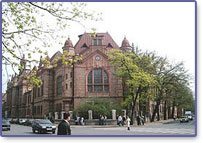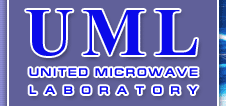HISTORY OF UNITED MICROWAVE LABORATORY

Laboratory was established in 1982 as "Microwave Cryoelectronic Laboratory" at Saint-Petersburg State Electrotechnical University and was reorganized in 1990 in "United Microwave Laboratory". Laboratory provides both applied research and engineering for elaboration of new tunable microwave devices based on traditional and nontraditional (superconductors, ferroelectrics) materials. Laboratory integrates research and engineering stuff of three groups working in the following directions:
- technology of thin films for microwave electronics
- research of microwave properties of bulk and thin film materials
- design of controlling and protecting microwave devices (limiters, tunable filters, phase-shifters, delay lines) and phased array antennas
Set of new science results and suggestions of their use in microwave electronics were first provided by our researchers:
- ion-plasma deposition technology of superconducting and ferroelectric thin films with parameters suitable for microwave application was elaborated on the base of investigation of initial stages of films growth and structure properties of the films.
- microwave measurements of the surface impedance and nonlinear parameters of the set of low-Tc and high-Tc superconductors and theoretical description of electrodynamical parameters of granular thin superconducting films.
- measurements and theoretical explanation of fast (<0.1ns) switching from superconductive to normal conductive state (S-N switching) under overcritical pulse current.
- creation of the new class of fast-acting microwave controlling and protective devices (switches, limiters) using the combination of S-N switching phenomenon in superconducting films and avalanche breakdown in semiconductors.
- investigation of nonlinear properties of thin ferroelectric films in the broad frequency range (1-80) GHz and creation of the new class of fast-acting mm wave controlling devices on their base (tunable filters, phase shifters, delay lines, VCO).
- creation of mm wave phased array antennas for Local Multipoint Distribution Systems (LMDS) employing ferroelectric phase shifters.
New class of tunable microwave devices based on superconductors and ferroelectrics was elaborated within the framework of more than 25 contracts with leading industrial and military Russian enterprises and 15 grants of Russian Science Academy. Laboratory maintains close contacts with foreign science community and commercial enterprises. Researches in a frame of grants and contracts for Samsung Electronics (Korea), Korea Research Institute of Standards and Science (Korea), FJGJ (Germany) and European Communities were carried out during the last years. From 1995 up to now laboratory develops the research and engineering activity under contracts with US commercial firms and leading US government enterprises (Sandia National Laboratories (1995-1997), National Renewable Energy Laboratory (1997-2004)). Six grants of US Department of Energy (DOE) were developed in laboratory during last 9 years.
Our researchers were awarded Microwave Year Prize at 27th European Microwave Conference (Jerusalem, 1997). Together with colleagues from National Renewable Energy Laboratory and Paratek Microwave Inc. (US) the laboratory won a 2001 "R&D 100" Award for technology of "DRWIN Electronically Scanning Antenna", that was included in list of 100 best technical-science works of US in 2001 year. During last seven years six senior researchers and four Ph.D. students working in laboratory were granted within a framework of Soros foundation program, the head of laboratory professor Andrey B. Kozyrev was granted as a Soros Professor. Two Ph.D. students were granted as Russian President Scholarships. Nine grants of Russian government in the filed of application of ferroelectrics on microwave were won during the 8 last years.
At present time we concentrate our efforts in area "Ferroelectrics at microwaves: film technology, properties, application."
More than 15 years experience of researchers of "United Microwave Laboratory" in directions of producing of ferroelectric films and their physical investigations, made it possible to create a new class of tunable microwave devices. These devices can be used in wireless communication and radar systems (in particular in anticollision car radar systems). The set of prototypes of low cost fast acting tunable filters, switches, delay lines, phase shifters and steerable beam antennas based on ferroelectric films have been created and tested in "United Microwave Laboratory" over frequency range (1-70) GHz.
In microwave applications the main advantages of ferroelectrics in comparison with usually used semiconductor or ferrite materials are:
- the high speed of the dielectric constant variation (tuning of devices) under electric field (the time of response is less than 0.1ns)
- the high power handling capability and the high level of microwave power corresponding to the irreversible destruction of ferroelectric film elements
- the high resistance to x-ray, neutron and other types of irradiation
- the low controlling consumption energy
- the low cost of manufacture of the ferroelectric elements
|

